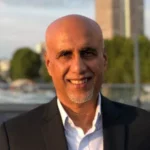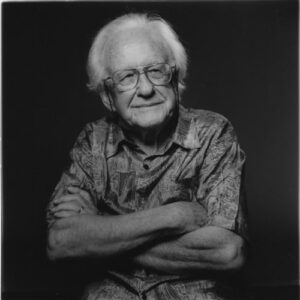Johan Galtung: Macrohistorian, Futurist, Peace Theorist
JOHAN GALTUNG MEMORIAL, 26 Feb 2024
Sohail Inayatullah – TRANSCEND Media Service
Because of the graciousness of Jim Dator and the World Futures Studies Federation I was fortunate to have spent over a decade in close contact with Johan Galtung. He spent much of the 1980s in Honolulu, Hawaii, running seminars at the University. I was working for the Hawaii Judiciary then as a futurist, and in 1987, Galtung became my advisor for my doctoral dissertation.
His skill, given he was a speaker of at least ten languages, was his ability to take complex ideas and communicate them in ways that the reader, the listener, could easily understand. When I first heard him speak on his structural theory of imperialism, I immediately understood why the poor – those in the periphery – related more to the elite, the center within their own regions, instead of with the periphery, and the periphery of the periphery, the downtrodden globally. I used his approach and wrote on piece on the futures of Hawaii; how the islands were peripheral in their development with capital flowing outwards to the US Mainland and Japan.
When I was taking him to lectures in Hawaii – Hawaii state government, the Hawaii Judiciary – I asked how he could deliver to so many groups without any anxiety. He looked at me and said: “the first 1000 times were difficult.” I understood clearly: practice, practice, and practice.
To practice, I knew I needed to read. Once when he was engaged in pedagogy, I reminded Galtung that I had read all his books. He laughed and said that could not be true. Then he smiled and said, “what about a structural theory of revolutions. “It was my turn to laugh, and I said, “you mean the small red book.
But it was in 1987 that our connection grew stronger. I showed him some of my publications, he instantly challenged me asking where will this lead to? I immediately enrolled in the doctoral program. There were no course requirements but when Galtung offered a course on Macrohistory in 1987, I enrolled. The eight of us in that course became close friends. Galtung was the professor but also a friend, inviting us all to his home for many dinners. I still stay in touch with some of the participants, particularly Otto Scharmer. That course was a life-changing event, and we would then go on to publish a book from that learning journey, Macrohistory and Macrohistorians.
Dator was the chair of my program but as the focus was on history, Galtung took the brunt of the work. When I submitted my doctoral proposal. He looked at it and threw it in the garbage. He said, you are selling your topic short. Instead, he suggested I engage in comparative history and epistemology. From that, my PhD became, Understanding Sarkar: The Indian episteme, Macrohistory, and Transformative Knowledge. At Galtung’s insistence, I compared Sarkar with the other greats in human history (Ibn Khaldun, Vico, Marx, Hegel, Sorokin, and more). But his toughness was minor compared to his generosity. When I gave him my 120,000-word thesis, instead of balking at the length, he read a chapter daily, and called me every evening with words of congratulation. When others criticized my focus on Sarkar, he said simply: send them more chapters – they don’t know what they don’t know.
His work was also pivotal in using dialectics to understand the emerging future. While my professor in Philosophy 101 at the University of Hawaii in 1975 suggested that if you are unable to think dialectically you are unable to think at all, Galtung argued the more contradictions an entity has the less likely it can survive. He could thus in 1982 argue with confidence that the Soviet Union would collapse within a decade – the contradictions were too great, the system not adaptive enough. By the year 2000, he made a similar prediction about the US and capitalism, that it too displayed too many contradictions to survive. I use this approach in futures-proofing, that is, reduce contradictions in any system and then thrivability is more likely.
After we both left Hawaii, I was fortunate to meet Galtung many times around the world – in Trier, “Taipei, Turku, Budapest, Barcelona, Brisbane, Mooloolaba, Seattle, and elsewhere – over the past few decades. I still remember how his words transformed the Asia Pacific Mayors Forum in Brisbane. When asked about his image of the future city – instead of the usual mantra of the smart city, he said, the city should be like the amazon jungle: green, living, growing, transforming: alive. His words impacted the few hundred delegates and the hundred plus Mayors. Of course, one Mayor protested, saying he just wanted more roads and cars.
In Taipei at the first international futures conference at Tamkang University, he gave a powerful talk on the nine Chinas, suggesting that peace was possible, if China moved toward a confederation, a pluralistic model. Galtung was unique in that along with theories of power, he always focused on possibilities and designs of change, as well as on peaceful strategies. Peace was not just the preferred future but the path as well. He had been inspired by Gandhi, the Buddha, and the world philosopher P.R. Sarkar.
Along with fascination with microhistory and the future, Galtung’s work was instrumental in the development of CLA. His map of peace having three levels, direct violence (litany), structural violence (system) and cultural violence (worldview) is the core of CLA. I merely added myth and metaphor, which I learned from William Irwin Thompson.
He, along with Jim Dator, were directly involved in me moving to Brisbane. I had applied for a post-doctoral fellowship at Queensland University of Technology. The intent was to work with Tony Stevenson at the Communication Centre and help with the move of the World Futures Studies Federation there. However, the university only gave post-docs to those who had a PhD in the sciences. Luckily one of the committee members had read Galtung, and when he saw the reference from him, they awarded me the fellowship,
There are some speakers I never tire of listening to – Galtung was one of them. While not a comedian, he was able to keep the audience mesmerized through humorous references to historical world thinkers. I am not sad, for Johan lived his life purpose and helped countless with their life purpose. I am truly appreciative of his life work and the many gifts he gave me and others.
________________________________________________
 Sohail Inayatullah is a Pakistani-born Australian academic, futures studies researcher and a professor at the Graduate Institute of Futures Studies at Tamkang University in Taipei and at the University of Melbourne. In 2016, he was awarded the first UNESCO Chair in Futures Studies.
Sohail Inayatullah is a Pakistani-born Australian academic, futures studies researcher and a professor at the Graduate Institute of Futures Studies at Tamkang University in Taipei and at the University of Melbourne. In 2016, he was awarded the first UNESCO Chair in Futures Studies.
Tags: Johan Galtung, Obituary
This article originally appeared on Transcend Media Service (TMS) on 26 Feb 2024.
Anticopyright: Editorials and articles originated on TMS may be freely reprinted, disseminated, translated and used as background material, provided an acknowledgement and link to the source, TMS: Johan Galtung: Macrohistorian, Futurist, Peace Theorist, is included. Thank you.
If you enjoyed this article, please donate to TMS to join the growing list of TMS Supporters.

This work is licensed under a CC BY-NC 4.0 License.
Read more
Click here to go to the current weekly digest or pick another article:
JOHAN GALTUNG MEMORIAL:
